The Interplay of Business, Society, and Planet: Sustainability
VerifiedAdded on 2023/06/08
|5
|1209
|156
Essay
AI Summary
This essay discusses the critical sustainability issues facing businesses today, including climate change, energy, water scarcity, and global equity. It emphasizes the importance of understanding how businesses address these challenges and how their activities impact sustainability. The essay also explores the triple bottom line approach as a method for businesses to measure their social, economic, and environmental performance. Furthermore, it touches upon the six forms of capital used by businesses and the six phases of sustainable business approaches, highlighting examples of companies that have successfully engaged in sustainable practices. The conclusion underscores that a healthy workforce, business competitiveness, and good stewardship of natural resources are crucial for corporate sustainability. Desklib provides access to this and other resources for students.
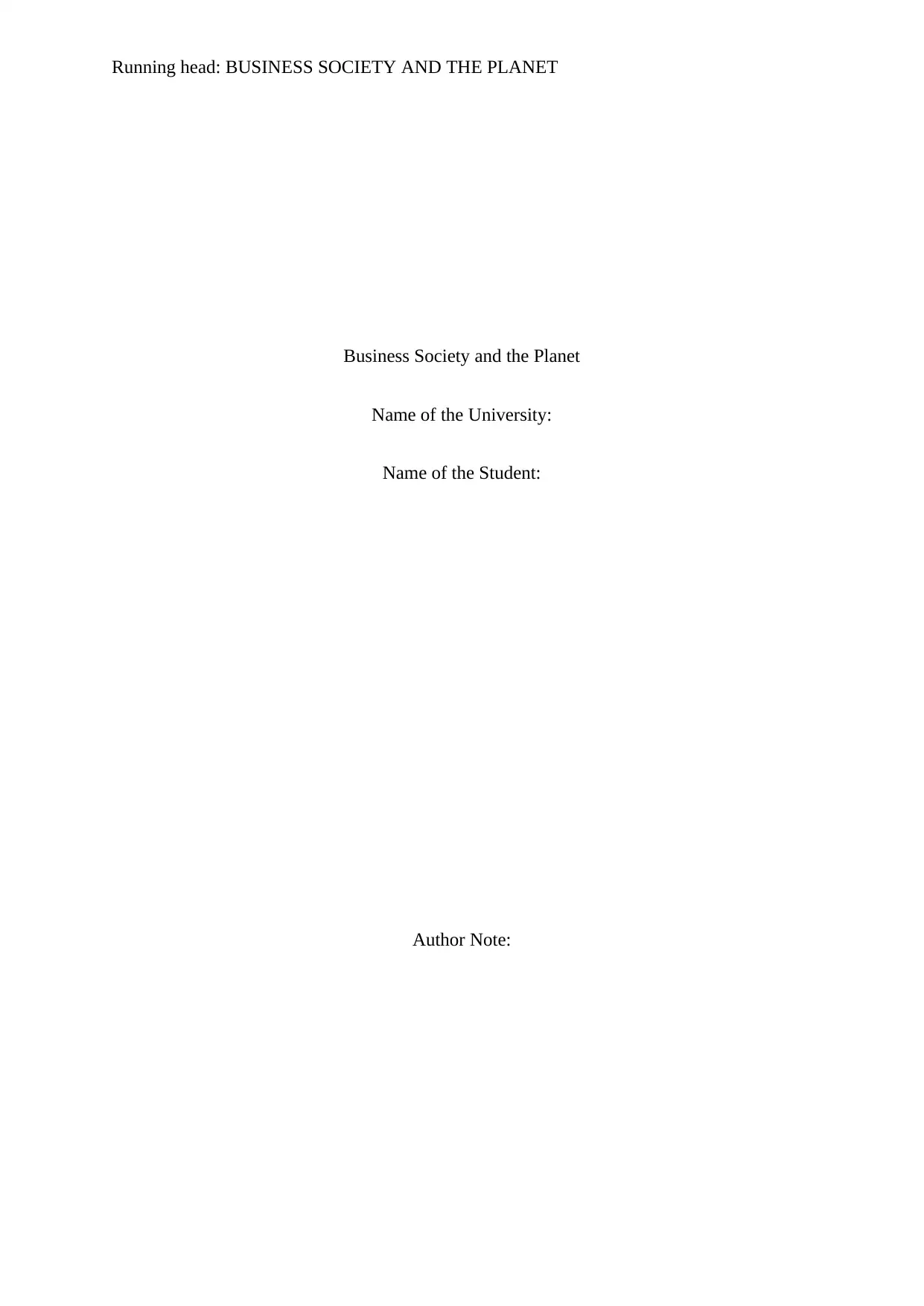
Running head: BUSINESS SOCIETY AND THE PLANET
Business Society and the Planet
Name of the University:
Name of the Student:
Author Note:
Business Society and the Planet
Name of the University:
Name of the Student:
Author Note:
Paraphrase This Document
Need a fresh take? Get an instant paraphrase of this document with our AI Paraphraser
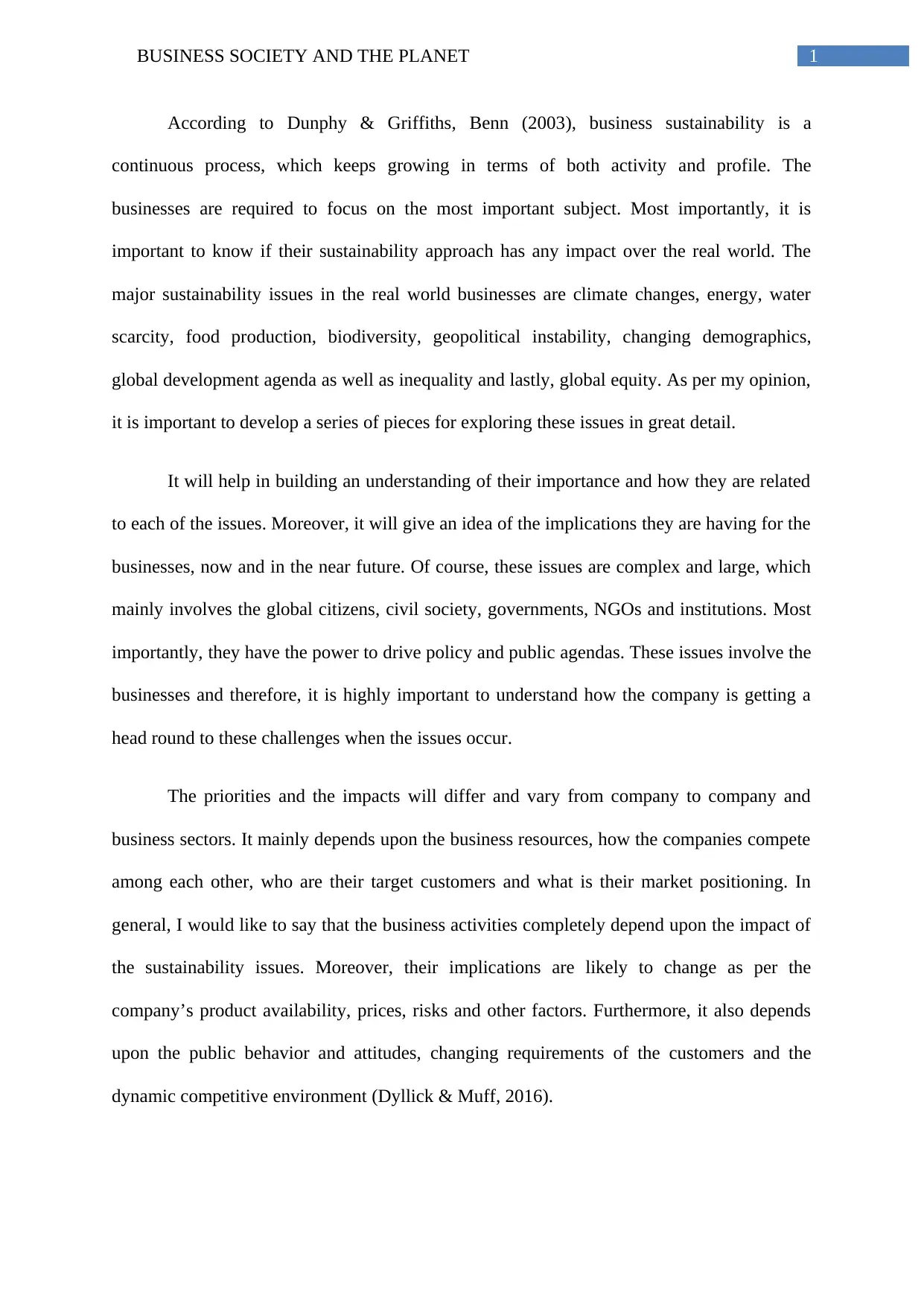
1BUSINESS SOCIETY AND THE PLANET
According to Dunphy & Griffiths, Benn (2003), business sustainability is a
continuous process, which keeps growing in terms of both activity and profile. The
businesses are required to focus on the most important subject. Most importantly, it is
important to know if their sustainability approach has any impact over the real world. The
major sustainability issues in the real world businesses are climate changes, energy, water
scarcity, food production, biodiversity, geopolitical instability, changing demographics,
global development agenda as well as inequality and lastly, global equity. As per my opinion,
it is important to develop a series of pieces for exploring these issues in great detail.
It will help in building an understanding of their importance and how they are related
to each of the issues. Moreover, it will give an idea of the implications they are having for the
businesses, now and in the near future. Of course, these issues are complex and large, which
mainly involves the global citizens, civil society, governments, NGOs and institutions. Most
importantly, they have the power to drive policy and public agendas. These issues involve the
businesses and therefore, it is highly important to understand how the company is getting a
head round to these challenges when the issues occur.
The priorities and the impacts will differ and vary from company to company and
business sectors. It mainly depends upon the business resources, how the companies compete
among each other, who are their target customers and what is their market positioning. In
general, I would like to say that the business activities completely depend upon the impact of
the sustainability issues. Moreover, their implications are likely to change as per the
company’s product availability, prices, risks and other factors. Furthermore, it also depends
upon the public behavior and attitudes, changing requirements of the customers and the
dynamic competitive environment (Dyllick & Muff, 2016).
According to Dunphy & Griffiths, Benn (2003), business sustainability is a
continuous process, which keeps growing in terms of both activity and profile. The
businesses are required to focus on the most important subject. Most importantly, it is
important to know if their sustainability approach has any impact over the real world. The
major sustainability issues in the real world businesses are climate changes, energy, water
scarcity, food production, biodiversity, geopolitical instability, changing demographics,
global development agenda as well as inequality and lastly, global equity. As per my opinion,
it is important to develop a series of pieces for exploring these issues in great detail.
It will help in building an understanding of their importance and how they are related
to each of the issues. Moreover, it will give an idea of the implications they are having for the
businesses, now and in the near future. Of course, these issues are complex and large, which
mainly involves the global citizens, civil society, governments, NGOs and institutions. Most
importantly, they have the power to drive policy and public agendas. These issues involve the
businesses and therefore, it is highly important to understand how the company is getting a
head round to these challenges when the issues occur.
The priorities and the impacts will differ and vary from company to company and
business sectors. It mainly depends upon the business resources, how the companies compete
among each other, who are their target customers and what is their market positioning. In
general, I would like to say that the business activities completely depend upon the impact of
the sustainability issues. Moreover, their implications are likely to change as per the
company’s product availability, prices, risks and other factors. Furthermore, it also depends
upon the public behavior and attitudes, changing requirements of the customers and the
dynamic competitive environment (Dyllick & Muff, 2016).
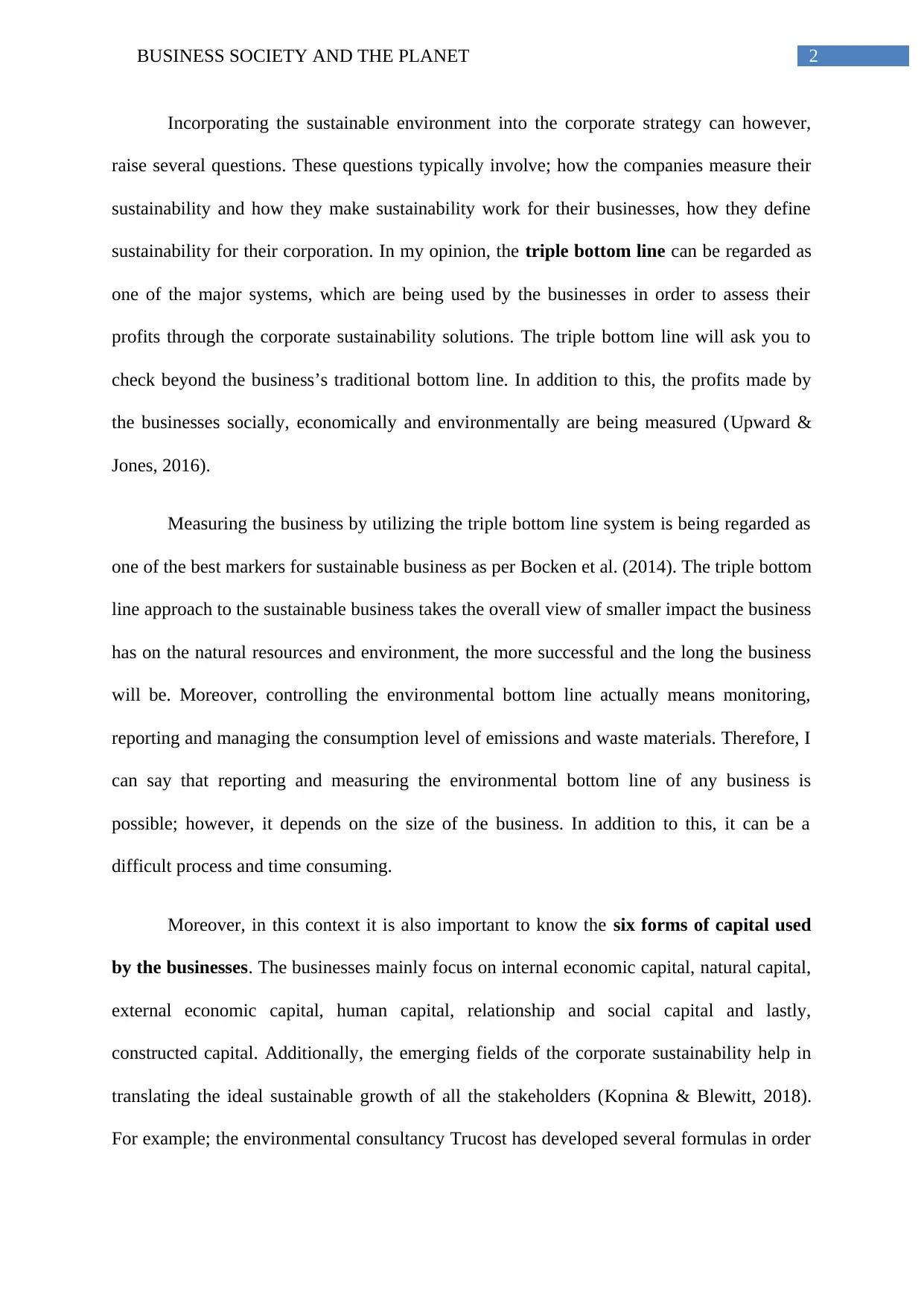
2BUSINESS SOCIETY AND THE PLANET
Incorporating the sustainable environment into the corporate strategy can however,
raise several questions. These questions typically involve; how the companies measure their
sustainability and how they make sustainability work for their businesses, how they define
sustainability for their corporation. In my opinion, the triple bottom line can be regarded as
one of the major systems, which are being used by the businesses in order to assess their
profits through the corporate sustainability solutions. The triple bottom line will ask you to
check beyond the business’s traditional bottom line. In addition to this, the profits made by
the businesses socially, economically and environmentally are being measured (Upward &
Jones, 2016).
Measuring the business by utilizing the triple bottom line system is being regarded as
one of the best markers for sustainable business as per Bocken et al. (2014). The triple bottom
line approach to the sustainable business takes the overall view of smaller impact the business
has on the natural resources and environment, the more successful and the long the business
will be. Moreover, controlling the environmental bottom line actually means monitoring,
reporting and managing the consumption level of emissions and waste materials. Therefore, I
can say that reporting and measuring the environmental bottom line of any business is
possible; however, it depends on the size of the business. In addition to this, it can be a
difficult process and time consuming.
Moreover, in this context it is also important to know the six forms of capital used
by the businesses. The businesses mainly focus on internal economic capital, natural capital,
external economic capital, human capital, relationship and social capital and lastly,
constructed capital. Additionally, the emerging fields of the corporate sustainability help in
translating the ideal sustainable growth of all the stakeholders (Kopnina & Blewitt, 2018).
For example; the environmental consultancy Trucost has developed several formulas in order
Incorporating the sustainable environment into the corporate strategy can however,
raise several questions. These questions typically involve; how the companies measure their
sustainability and how they make sustainability work for their businesses, how they define
sustainability for their corporation. In my opinion, the triple bottom line can be regarded as
one of the major systems, which are being used by the businesses in order to assess their
profits through the corporate sustainability solutions. The triple bottom line will ask you to
check beyond the business’s traditional bottom line. In addition to this, the profits made by
the businesses socially, economically and environmentally are being measured (Upward &
Jones, 2016).
Measuring the business by utilizing the triple bottom line system is being regarded as
one of the best markers for sustainable business as per Bocken et al. (2014). The triple bottom
line approach to the sustainable business takes the overall view of smaller impact the business
has on the natural resources and environment, the more successful and the long the business
will be. Moreover, controlling the environmental bottom line actually means monitoring,
reporting and managing the consumption level of emissions and waste materials. Therefore, I
can say that reporting and measuring the environmental bottom line of any business is
possible; however, it depends on the size of the business. In addition to this, it can be a
difficult process and time consuming.
Moreover, in this context it is also important to know the six forms of capital used
by the businesses. The businesses mainly focus on internal economic capital, natural capital,
external economic capital, human capital, relationship and social capital and lastly,
constructed capital. Additionally, the emerging fields of the corporate sustainability help in
translating the ideal sustainable growth of all the stakeholders (Kopnina & Blewitt, 2018).
For example; the environmental consultancy Trucost has developed several formulas in order
⊘ This is a preview!⊘
Do you want full access?
Subscribe today to unlock all pages.

Trusted by 1+ million students worldwide
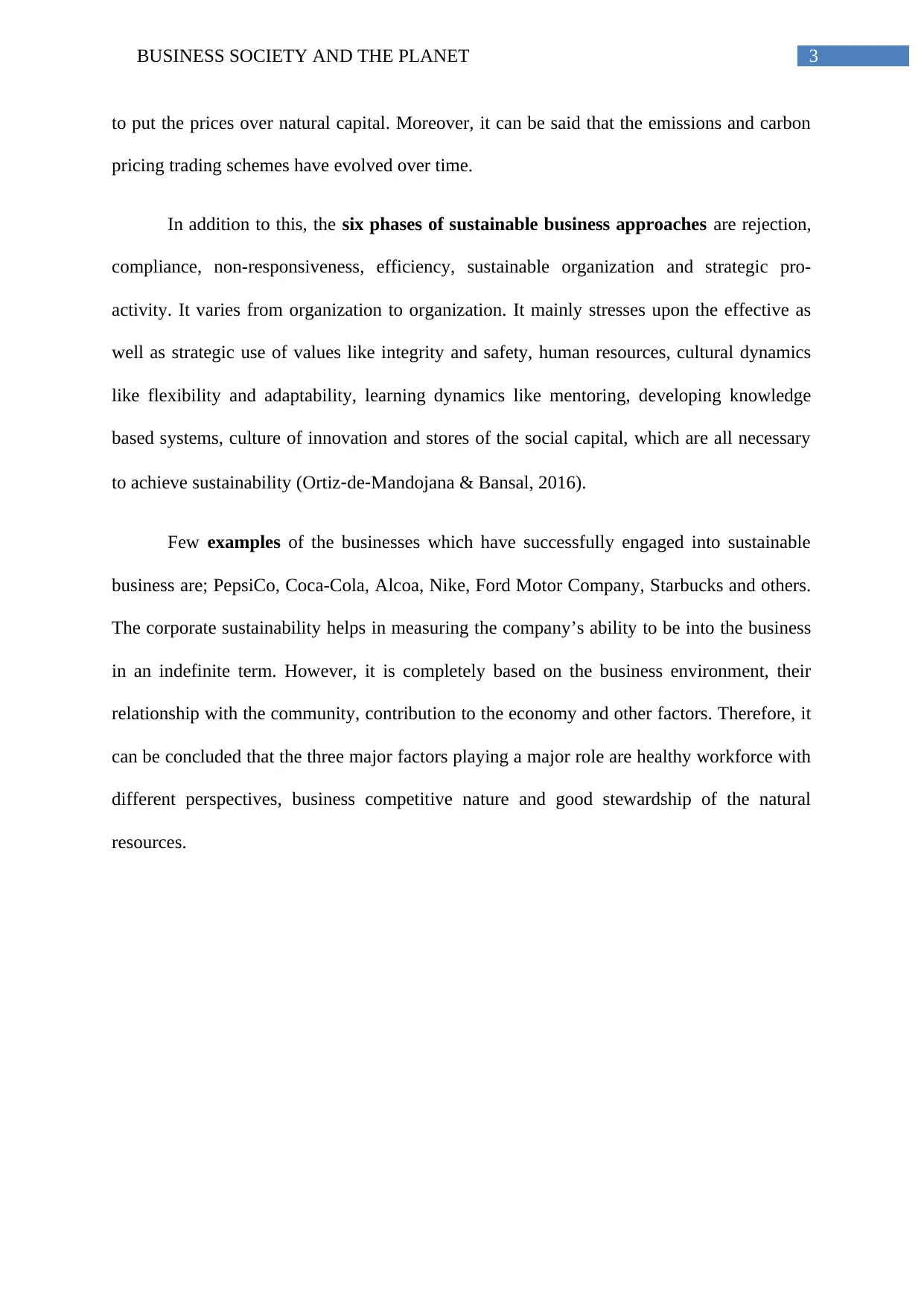
3BUSINESS SOCIETY AND THE PLANET
to put the prices over natural capital. Moreover, it can be said that the emissions and carbon
pricing trading schemes have evolved over time.
In addition to this, the six phases of sustainable business approaches are rejection,
compliance, non-responsiveness, efficiency, sustainable organization and strategic pro-
activity. It varies from organization to organization. It mainly stresses upon the effective as
well as strategic use of values like integrity and safety, human resources, cultural dynamics
like flexibility and adaptability, learning dynamics like mentoring, developing knowledge
based systems, culture of innovation and stores of the social capital, which are all necessary
to achieve sustainability (Ortiz‐de‐Mandojana & Bansal, 2016).
Few examples of the businesses which have successfully engaged into sustainable
business are; PepsiCo, Coca-Cola, Alcoa, Nike, Ford Motor Company, Starbucks and others.
The corporate sustainability helps in measuring the company’s ability to be into the business
in an indefinite term. However, it is completely based on the business environment, their
relationship with the community, contribution to the economy and other factors. Therefore, it
can be concluded that the three major factors playing a major role are healthy workforce with
different perspectives, business competitive nature and good stewardship of the natural
resources.
to put the prices over natural capital. Moreover, it can be said that the emissions and carbon
pricing trading schemes have evolved over time.
In addition to this, the six phases of sustainable business approaches are rejection,
compliance, non-responsiveness, efficiency, sustainable organization and strategic pro-
activity. It varies from organization to organization. It mainly stresses upon the effective as
well as strategic use of values like integrity and safety, human resources, cultural dynamics
like flexibility and adaptability, learning dynamics like mentoring, developing knowledge
based systems, culture of innovation and stores of the social capital, which are all necessary
to achieve sustainability (Ortiz‐de‐Mandojana & Bansal, 2016).
Few examples of the businesses which have successfully engaged into sustainable
business are; PepsiCo, Coca-Cola, Alcoa, Nike, Ford Motor Company, Starbucks and others.
The corporate sustainability helps in measuring the company’s ability to be into the business
in an indefinite term. However, it is completely based on the business environment, their
relationship with the community, contribution to the economy and other factors. Therefore, it
can be concluded that the three major factors playing a major role are healthy workforce with
different perspectives, business competitive nature and good stewardship of the natural
resources.
Paraphrase This Document
Need a fresh take? Get an instant paraphrase of this document with our AI Paraphraser
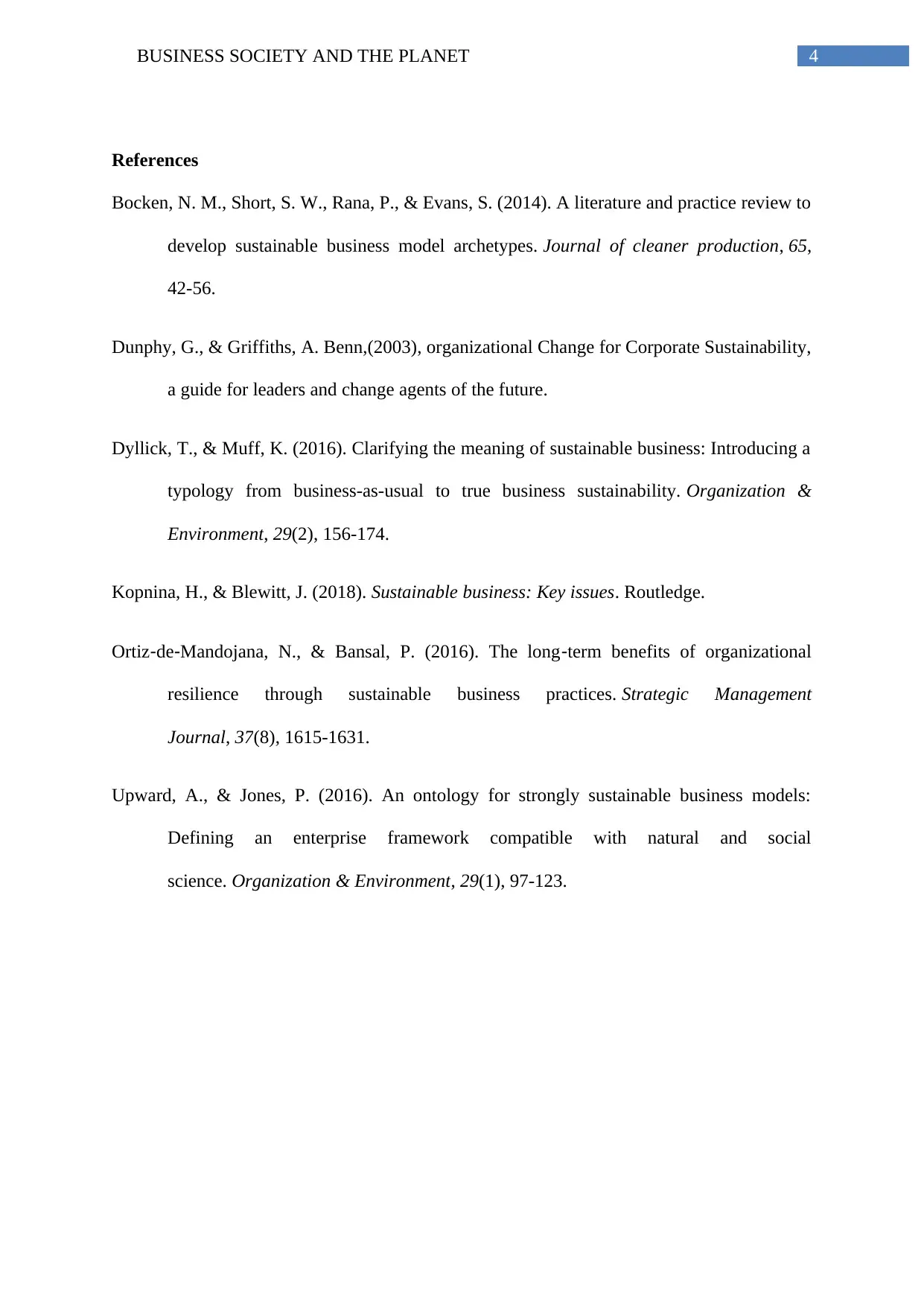
4BUSINESS SOCIETY AND THE PLANET
References
Bocken, N. M., Short, S. W., Rana, P., & Evans, S. (2014). A literature and practice review to
develop sustainable business model archetypes. Journal of cleaner production, 65,
42-56.
Dunphy, G., & Griffiths, A. Benn,(2003), organizational Change for Corporate Sustainability,
a guide for leaders and change agents of the future.
Dyllick, T., & Muff, K. (2016). Clarifying the meaning of sustainable business: Introducing a
typology from business-as-usual to true business sustainability. Organization &
Environment, 29(2), 156-174.
Kopnina, H., & Blewitt, J. (2018). Sustainable business: Key issues. Routledge.
Ortiz‐de‐Mandojana, N., & Bansal, P. (2016). The long‐term benefits of organizational
resilience through sustainable business practices. Strategic Management
Journal, 37(8), 1615-1631.
Upward, A., & Jones, P. (2016). An ontology for strongly sustainable business models:
Defining an enterprise framework compatible with natural and social
science. Organization & Environment, 29(1), 97-123.
References
Bocken, N. M., Short, S. W., Rana, P., & Evans, S. (2014). A literature and practice review to
develop sustainable business model archetypes. Journal of cleaner production, 65,
42-56.
Dunphy, G., & Griffiths, A. Benn,(2003), organizational Change for Corporate Sustainability,
a guide for leaders and change agents of the future.
Dyllick, T., & Muff, K. (2016). Clarifying the meaning of sustainable business: Introducing a
typology from business-as-usual to true business sustainability. Organization &
Environment, 29(2), 156-174.
Kopnina, H., & Blewitt, J. (2018). Sustainable business: Key issues. Routledge.
Ortiz‐de‐Mandojana, N., & Bansal, P. (2016). The long‐term benefits of organizational
resilience through sustainable business practices. Strategic Management
Journal, 37(8), 1615-1631.
Upward, A., & Jones, P. (2016). An ontology for strongly sustainable business models:
Defining an enterprise framework compatible with natural and social
science. Organization & Environment, 29(1), 97-123.
1 out of 5
Related Documents
Your All-in-One AI-Powered Toolkit for Academic Success.
+13062052269
info@desklib.com
Available 24*7 on WhatsApp / Email
![[object Object]](/_next/static/media/star-bottom.7253800d.svg)
Unlock your academic potential
Copyright © 2020–2025 A2Z Services. All Rights Reserved. Developed and managed by ZUCOL.




